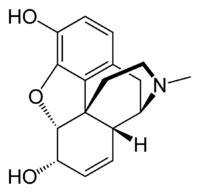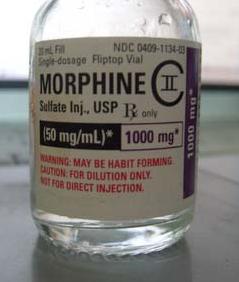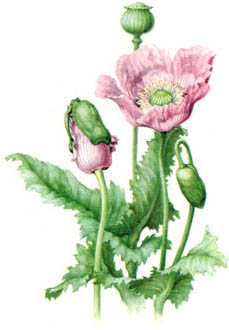|
HOME >>
API >>
Morphine HCl

|
Morphine HCl Analgesic BP /
EP

 |
Molecular Formula :
C17H19NO3
Molecular Weight :
285.34
CAS No. :
57-27-2
Chemical Name :
alchemists of Byzantine
Specifications : |
Morphine (INN)is a highly potent opiate analgesic
psychoactive drug, is the principal active ingredient in Papaver
somniferum (opium poppy, or simply opium), is considered to be the
prototypical opioid. Like other opioids, e.g. oxycodone (OxyContin,
Percocet, Percodan), hydromorphone (Dilaudid, Palladone), and
diacetylmorphine (Heroin), morphine acts directly on the central
nervous system (CNS) to relieve pain. Morphine has a high potential
for addiction; tolerance and both physical and psychological
dependence develop rapidly.
Morphine hydrochloride, or Muriate of Morphia, C17H19NO3, HCl, 3H2O,
may be prepared by neutralising pure morphine, suspended in hot
water, with diluted hydrochloric acid, concentrating the solution,
cooling, and setting it aside to crystallise. It is also official in
the U.S.P. It occurs in white, acicular crystals, or as a white,
odourless, micro-crystalline powder, having a bitter taste. Its
aqueous solution is neutral to litmus. At 100° it loses its water of
crystallisation, at 250° it becomes brown, then chars, but does not
melt. On complete ignition it usually leaves a visible, but not
weighable, residue. On adding ammonia to an aqueous solution of
morphine, the base forms a crystalline precipitate which, when
collected, washed, and dried, should respond to the tests given
under Morphina. The precipitate formed in this way should not yield
more than traces to benzene (absence of other alkaloids). It is an
open question whether morphine hydrochloride dissolves in sulphuric
acid with or without colour, some authorities maintaining that a
pale rose colouration is produced. The method of applying the test
may account for the conflicting statements, as experiments have
shown that, though a faint pink colouration occurs at first, the
solution becomes colourless on shaking. An aqueous solution (1 in
30) to which potassium carbonate has been added should not impart
any colour to chloroform (absence of apomorphine). Assayed
gravimetrically, the hydrochloride should yield 75.5 per cent. of
anhydrous morphine.
Soluble in water (1 in 24), boiling water (1 in 1), alcohol
(1 in 50), glycerin (1 in 8); insoluble in ether or chloroform.
Action and Uses—Morphine hydrochloride has the general
medicinal properties of the salts of morphine (see Morphina). It is
one of the most permanent salts of the alkaloid, and where its
solubility admits, it is preferred to the salts of the organic
acids. The official Liquor Morphinae Hydrochloridi is the most
convenient preparation for general administration, 11 minims
containing 1/10 grain of morphine hydrochloride. For use as mildly
sedative and expectorant lozenges, Trochiscus Morphinae and
Trochiscus Morphinae et Ipecacuanhae are suitable. Pastilles of
morphine, morphine and cocaine, and morphine and bismuth are also
prepared. Suppositoria Morphinae contain 1/4 grain of morphine
hydrochloride in each; they are also used two, three, or four times
this strength. Morphine hydrochloride is sometimes given in pills,
prepared by triturating the alkaloidal salt with sugar of milk, and
massing with syrup of glucose. Linctus Sedativus is a convenient
preparation to allay incessant cough and produce sleep.
Insufflations of morphine (1/4 grain), with 1 grain of bismuth
oxychloride or 1 1/2 grains of starch are used for the throat and
larynx: it is also a constituent of Insufflatio Bismuthi et
Morphinae (Ferrier's Snuff), for use in nasal catarrh. Tablets of
morphine hydrochloride are made in all strengths for the preparation
of solutions for hypodermic use; the B.P. Injectio Morphinae
Hypodermica is, however, prepared with morphine tartrate. Morphine
hydrochloride is incompatible with alkalies, alkali earths,
vegetable astringents, and salts of the heavy metals. In cases of
poisoning by morphine hydrochloride the antidotes are those of
morphine.
Dose.—8 to 30 milligrams (1/8 to 1/2 grain).
PREPARATIONS.
Linctus Sedativus, B.P.C.—SEDATIVE LINCTUS. Syn.—Linctus
Morphinae Acidus.
Each fluid drachm contains about 1/32 grain of morphine
hydrochloride, with lemon juice, emulsion of chloroform, and
glycerin. Dose.—2 to 4 mils (1/2 to 1 fluid drachm).
Liquor Morphinae Bimeconatis, B.P., 1885.—SOLUTION OF MORPHINE
BIMECONATE.
Morphine hydrochloride, 9 grains; solution of ammonia, a sufficient
quantity; meconic acid, 6 grains; alcohol, 1/2 fluid ounce;
distilled water, a sufficient quantity. Dissolve the morphine
hydrochloride in 2 or 3 fluid drachms of the distilled water,
warming if necessary; then add sufficient solution of ammonia to
precipitate the morphine entirely. Cool, filter, wash the
precipitate with distilled water until free from chloride; then
drain and mix with sufficient water to produce 1 1/2 ounces.
Finally, add the alcohol and meconic acid, and dissolve. This
preparation contains about 1 1/4 per cent. of morphine bimeconate,
and is about the same strength in this respect as tincture of opium.
It is sometimes used in place of the official solutions of morphine,
over which, however, it presents no advantages. Dose.—1/4 to 2 1/2
mils (5 to 40 minims),
Liquor Morphinae Hydrochloridi, B.P.—SOLUTION OF HYDROCHLORIDE.
Syn.—Liquor Morphinae; Solution of Hydrochlorate of Morphine.
Morphine hydrochloride, 1; diluted hydrochloric acid, 2; alcohol,
distilled water, sufficient to produce 100. Dissolve the morphine
hydrochloride in the alcohol, previously mixed with 25 of distilled
water and the acid, and add sufficient distilled water to make up to
the required volume. This solution provides a convenient means of
administering, morphine, and is commonly used when "Liquor Morphinae"
is ordered, unless there is some obvious objection to the presence
of hydrochloric acid. Dose.—1/2 to 4 mils (10 to 60 minims).
Suppositoria Morphinae, B.P.—MORPHINE SUPPOSITORIES.
Morphine hydrochloride, 1.7; oil of theobroma, sufficient to produce
100. Mix the morphine hydrochloride thoroughly with a small quantity
of the melted oil of theobroma, add the mixture to the remainder of
the oil, stir well together, and divide into suppositories each
weighing about 1 gramme (15 grains). Each suppository contains 1/4
grain of morphine hydrochloride. Morphine suppositories are employed
as a sedative to allay pain. The action of the morphine is exerted
only after absorption.
Trochisci Morphinae et Ipecacuanhae Compressi, B.P.C.—COMPRESSED
MORPHINE AND IPECACUANHA LOZENGES.
Each lozenge contains morphine hydrochloride, about 1/36 grain;
ipecacuanha root, in powder, 1/12 grain; with a sufficient quantity
of refined sugar, gum acacia, tincture of tolu, and theobroma
emulsion. They are used similarly to morphine and ipecacuanha
lozenges.
Trochiscus Morphinae B.P.—MORPHINE LOZENGE.
Each lozenge contains morphine hydrochloride, 1/36 grain; with a
sufficient quantity of tolu basis. Morphine lozenges are used as a
sedative in cough. They act after absorption.
Trochiscus Morphinae et Ipecacuanhae, B.P.—MORPHINE AND
IPECACUANHA LOZENGE.
Each lozenge contains morphine hydrochloride, 1/36 grain;
ipecacuanha root, in powder, 1/12 grain; with a sufficient quantity
of tolu basis. Morphine and ipecacuanha lozenges axe used as a
sedative and expectorant in cough.
 Note:
These API/ chemicals are designated as those that are used in
the manufacture of the controlled substances and are important to
the manufacture of the substances. For any (Control Substance)
products Import and Export *** subjected to your country government
laws /control substance ACT. Note:
These API/ chemicals are designated as those that are used in
the manufacture of the controlled substances and are important to
the manufacture of the substances. For any (Control Substance)
products Import and Export *** subjected to your country government
laws /control substance ACT.
Note /Government Notification:
These chemicals are designated as those that are used in the
manufacture of the controlled substances and are important to the
manufacture of the substances. For any (Control Substance) products
Import and Export *** subjected to your country government laws
/control substance ACT.
Information: The information on this web page is provided to
help you to work safely, but it is intended to be an overview of
hazards, not a replacement for a full Material Safety Data Sheet (MSDS).
MSDS forms can be downloaded from the web sites of many chemical
suppliers. ,also that the information on the PTCL Safety web site,
where this page was hosted, has been copied onto many other sites,
often without permission. If you have any doubts about the veracity
of the information that you are viewing, or have any queries, please
check the URL that your web browser displays for this page. If the
URL begins "www.tajapi.com/www/Denatonium Benzoate.htm/" the page is
maintained by the Safety Officer in Physical Chemistry at Oxford
University. If not, this page is a copy made by some other person
and we have no responsibility for it.
The Controlled Substances Act (CSA) was enacted into law by the
Congress of the United States as Title II of the Comprehensive Drug
Abuse Prevention and Control Act of 1970.[1] The CSA is the federal
U.S. drug policy under which the manufacture, importation,
possession, use and distribution of certain substances is regulated.
The Act also served as the national implementing legislation for the
Single Convention on Narcotic Drugs.
|


|












